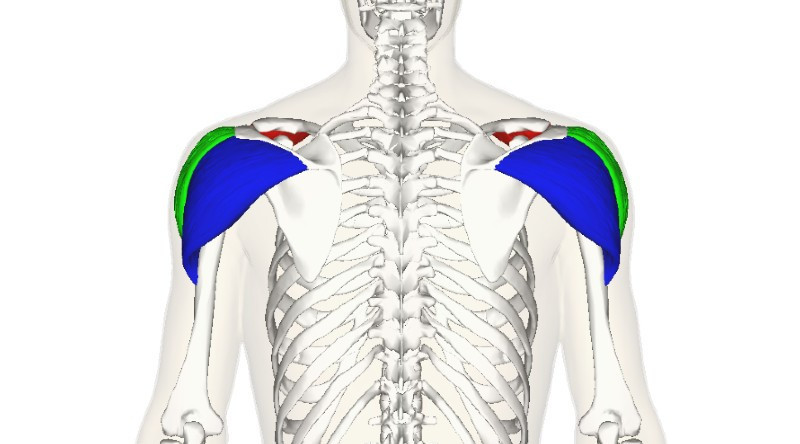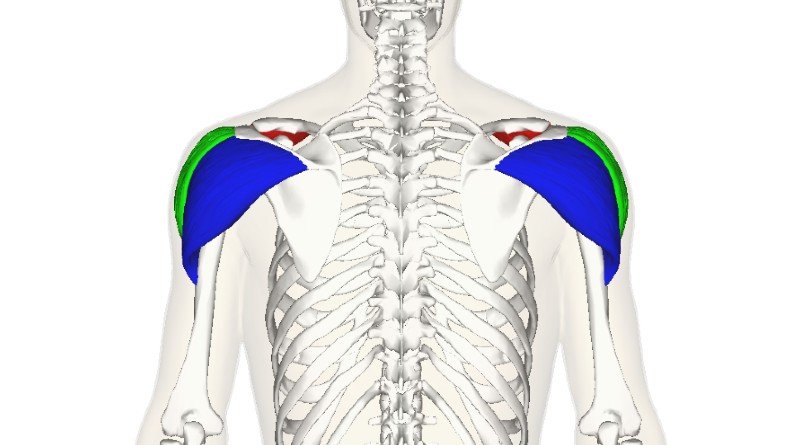Are you tired of having small, underdeveloped rear delts? Do you want to add size and definition to this muscle group, but don’t know where to start? Don’t worry, you’re not alone. Many people struggle to target and strengthen their rear delts, which can lead to imbalances and an underdeveloped appearance. But with the right techniques and dedication, it is possible to build bigger rear delts. In this article, we’ll go over a few effective strategies for adding size and definition to your rear delts, including isolation exercises, compound movements, and the use of resistance bands. So if you’re ready to take your rear delt development to the next level, keep reading to learn more.

Genetics and muscle fiber distribution
Genetics and muscle fiber distribution can play a significant role in the size and development of your rear delts, as well as other muscle groups. Here’s a little more information on how these factors can impact your muscle growth:
Genetics: Your genetic makeup can influence a number of factors related to muscle development, including muscle fiber type, muscle size, and strength.
Some people are naturally more prone to building muscle than others, due in part to their genetics. If you have a family history of well-developed muscles, it’s likely that you may also have a genetic advantage when it comes to building muscle.
However, genetics is just one piece of the puzzle. With consistent training and proper nutrition, anyone can make progress and improve their muscle development, regardless of their genetics.
Muscle fiber type: There are two types of muscle fibers: slow twitch and fast twitch. Slow twitch fibers are more resistant to fatigue and are typically used for endurance activities, while fast twitch fibers are more explosive and are used for short bursts of energy.
Your muscle fiber type is largely determined by genetics, but it can also be influenced by training and nutrition. Fast twitch fibers have the potential to grow larger and stronger than slow twitch fibers, which means that if you have a higher proportion of fast twitch fibers, you may have an advantage when it comes to building muscle.
Muscle fiber distribution: The distribution of muscle fibers in a particular muscle group can also play a role in muscle size and development.
Some people may have a higher proportion of fast twitch fibers in their rear delts, for example, which could make it easier for them to build bigger muscles in this area.
On the other hand, others may have a higher proportion of slow twitch fibers, which could make it more challenging to build size and definition in the rear delts.
It’s important to keep in mind that genetics and muscle fiber distribution are just two of many factors that can impact muscle development. With consistent training and proper nutrition, it is possible to make progress and improve the size and definition of your rear delts, regardless of your genetics or muscle fiber distribution.
Lack of targeted exercises for rear delts
If you’re struggling to build and strengthen your rear delts, you may be wondering what’s holding you back. There are a number of potential reasons why your rear delts may be underdeveloped, and addressing these issues can help you make progress and achieve the defined, muscular appearance you desire.
One potential reason for small rear delts is a lack of targeted exercises in your training routine. The rear delts, also known as the posterior deltoids, are responsible for shoulder extension and external rotation.
Therefore, exercises that isolate and target these movements can be particularly effective for building and strengthening the rear delts. If you’re not including enough of these exercises in your routine, it could be holding back your progress.
By including targeted exercises you can make progress and achieve the defined, muscular rear delts you desire.
Poor posture and muscle imbalances
Another reason for small rear delts could be poor posture and muscle imbalances. Poor posture can contribute to an underdeveloped appearance in the rear delts, as well as other muscle groups.
By maintaining good posture and engaging your core, you can help to ensure that your muscles are being worked properly and evenly.
In addition, muscle imbalances can also lead to small rear delts if certain muscle groups are being overworked while others are being neglected.
By including a variety of exercises that target all of your major muscle groups, you can help to maintain balance and ensure that your muscles are working together effectively.
Visualizing dropping your shoulder blades into your back pockets can be a helpful mental cue for engaging your rear delts and maintaining good posture.
When you think about dropping your shoulder blades into your back pockets, it can help to remind you to keep your shoulders down and back, which can help to engage your rear delts and maintain proper posture.
Good posture is important for a number of reasons, including improving the effectiveness of your exercises and preventing muscle imbalances.Over-reliance on front delt-dominant exercises can also contribute to small rear delts.
Pssst: If you want to improve your posture, you’re going to have to deal with your lack of flexibility and mobility. Find out how I did that here.
Over-reliance on front delt-dominant exercises
An over-reliance on front delt-dominant exercises can be a common reason for small rear delts.
The front delts, or anterior deltoids, are responsible for shoulder flexion and are often targeted in exercises such as bench press and military press. While these exercises can be effective for building overall size and strength, it’s important to also include exercises that target the rear delts to maintain balance and avoid muscle imbalances.
If you’re primarily focusing on front delt-dominant exercises, it’s likely that your rear delts are not getting enough direct attention.
As a result, they may not be developing at the same rate as your front delts, leading to an imbalanced and underdeveloped appearance.
To avoid this issue, it’s important to incorporate a variety of exercises that target all of the major muscle groups, including the rear delts. This can help to ensure that all of your muscles are being properly trained and developed, and can help to prevent muscle imbalances.
In addition to including targeted rear delt exercises, such as bent-over dumbbell lateral raises and cable face pulls, it’s also important to pay attention to your posture and technique during exercises that involve the front delts.
By keeping your shoulders down and back and engaging your core, you can help to ensure that your rear delts are also being properly activated and worked.
Overall, it’s important to strike a balance in your training and give all of your major muscle groups the attention they deserve. By avoiding over-reliance on front delt-dominant exercises and incorporating targeted rear delt exercises, you can help to achieve a balanced, defined, and muscular appearance.
Insufficient volume and intensity in training routine
Insufficient volume and intensity in your training routine can be a common reason for small, underdeveloped rear delts.
To build and strengthen this muscle group, it’s important to use a weight that challenges you and aim for a sufficient number of reps and sets. If you’re not using enough volume and intensity in your training, it’s likely that your rear delts are not being challenged enough to stimulate growth and development.
One way to increase the volume and intensity of your training is to gradually increase the weight you use for your exercises. As you get stronger, you should aim to increase the amount of weight you use to continue challenging your muscles and making progress. In addition to increasing the weight, it’s also important to aim for a sufficient number of reps and sets.
This can help to provide your muscles with the stimulus they need to grow and develop.
Another way to increase the volume and intensity of your training is to vary your training routine. This can include using different exercises, changing up the number of reps and sets, and incorporating different types of training, such as high-intensity interval training or supersets.
By consistently challenging your muscles and providing them with new stimuli, you can help to ensure that you are making progress and achieving the defined, muscular rear delts you desire.
Effective Strategies for Building Big Rear Delts
If you’re looking to add some size and definition to your rear delts, you’re not alone. Many people struggle to target and strengthen this muscle group, which can lead to imbalances and an underdeveloped appearance. But with the right techniques and dedication, it is possible to build bigger rear delts. Here are a few effective strategies to try.
- Use a variety of rep ranges and weights. As with any muscle group, it’s important to vary your training to continue making progress. Mix up the number of reps and the amount of weight you use to keep your muscles guessing and avoid plateaus.
- Include reverse flyes in your routine. Reverse flyes, also known as bent-over flyes, are a great exercise for targeting the rear delts. They can be done with dumbbells, cables, or a resistance band. Be sure to keep a slight bend in your elbows and focus on squeezing your shoulder blades together as you lift the weights.
- Pay attention to your posture. Poor posture can contribute to underdeveloped rear delts. Make sure to engage your core and keep your shoulders down and back to maintain good posture during your exercises.
- Incorporate compound exercises. While isolation exercises are important for targeting specific muscle groups, compound exercises that involve multiple muscle groups can also be effective for building overall size and strength. Examples include rows, pull-ups, and chin-ups, which all involve the rear delts.
- Try using a resistance band. Resistance bands are a versatile and convenient tool for working out at home or on the go. They can be used to perform a variety of exercises that target the rear delts, including lateral raises and face pulls.
- Don’t neglect the rest of your body. Building bigger rear delts is not just about focusing on those specific muscles. It’s important to also train other muscle groups, including your chest, back, and legs, to maintain balance and overall muscle development.
Here is an example of how you can incorporate rear delt training into a “back day” workout:
Warm up:
- On the floor Y’s and T’s: Start by lying on your stomach on a mat with your arms extended straight out to the sides. Lift your arms and chest off the ground, forming a Y shape with your body. Hold for a few seconds and then lower back down. Next, lift your arms and chest off the ground again, this time forming a T shape with your body. Hold for a few seconds and then lower back down. Repeat for a total of 10-15 reps of each exercise.
Back workout:
- Chins: Grab the chin-up bar with an overhand grip and lift yourself up until your chin is above the bar. Slowly lower yourself back down. Aim for 3-4 sets of 8-12 reps.
- Dumbbell bent over rows: Grab a pair of dumbbells and position yourself in front of a flat bench. Place one knee and one hand on the bench and hinge forward at the hips, keeping your back straight and core engaged. Lift the dumbbells to your sides, squeezing your shoulder blades together. Lower the dumbbells back down and repeat. Aim for 3-4 sets of 8-12 reps.
Rear delt finishers:
- Rear delt flyes: Hold a pair of dumbbells and bend forward at the hips, keeping your back straight and core engaged. Lift the dumbbells out to the sides, keeping your elbows slightly bent. Lower the dumbbells back down and repeat. Aim for 3-4 sets of 8-12 reps.
The warm up exercises, on the floor Y’s and T’s, will engage and activate the rear delts, as well as help to strengthen the mind-muscle connection between your brain and the muscle group.
It’s important to maintain this connection during your workout, as it can help to improve the effectiveness of your exercises and ensure that you are targeting the right muscles.
During the bent over rows, make sure to focus on squeezing your shoulder blades together and holding that squeeze at the top of each row. This will help to engage the rear delts and ensure that they are getting a good workout.
By the time you get to the rear delt flyes, your rear delts will likely be pre-fatigued from the warm up and the rows. This means that it’s all about getting the burn on every set and hitting a total rep count of 60 flyes.
Make sure to use a weight that allows you to complete all of the reps with good form, but still challenges you. Remember to take breaks as needed, but try to push through the fatigue and get the most out of your sets.
5 Tips for Building Bigger, Stronger Rear Delts: A Comprehensive Guide
In conclusion, we’ve learned about a number of potential reasons why your rear delts may be small and underdeveloped, and how to address these issues to achieve the defined, muscular rear delts you desire. We’ve discussed the importance of incorporating targeted exercises, such as bent-over dumbbell lateral raises and cable face pulls, into your training routine, as well as maintaining good posture, avoiding muscle imbalances, and increasing the volume and intensity of your training.
We’ve also provided an example of how to incorporate rear delt training into a “back day” workout, including a warm up with on the floor Y’s and T’s, a back workout consisting of chins and bent over rows, and rear delt flyes as finishers. By following this type of workout and focusing on engaging your rear delts, you can make progress and achieve the muscular appearance you desire.
Remember, building muscle takes time and dedication, so don’t get discouraged if you don’t see immediate results. With consistent effort and proper nutrition, you can make progress and achieve the muscular physique you desire. So keep working hard, stay focused, and don’t give up – the defined, muscular rear delts you’ve always wanted are within reach.

